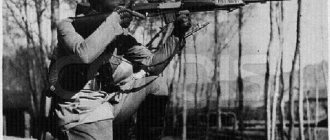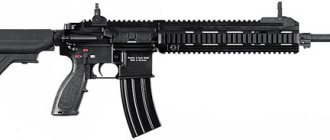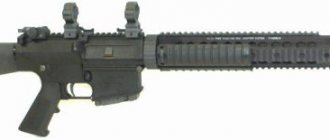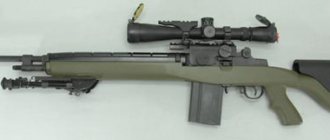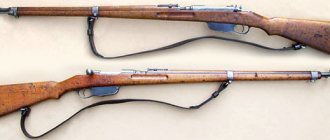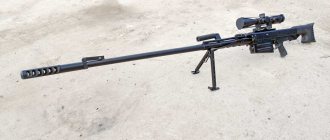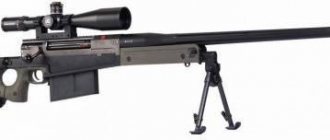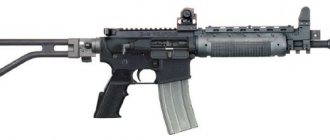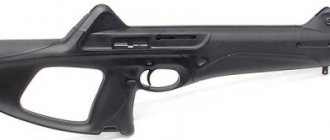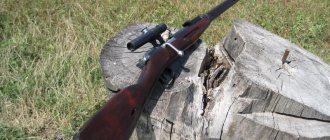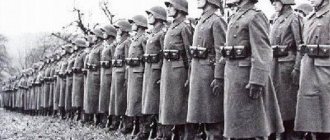ammunition
US Krags were chambered for rim .30-40 round Krags, also known as ".30 Army."
From 1890 to 1893 a 230-grain steel- or nickel-silver jacket bullet was issued, for which no ballistic data is known. From 1894 to September 1899, a 220 grain jacketed bullet loading was fired using 40 grains of nitrocelluose powder, which developed approximately 40,000 psi and a muzzle velocity of 2,000 feet per second (610 m/s) in Krag rifles and 1,960 ft/s s (600 m/s) in a shorter carbine. In October 1899, after reviewing the experience of the Spanish–American War, a new load was developed for the .30 Army in an attempt to match the ballistics of the 7×57mm Mauser cartridge. The new load increased the projectile speed of the Krag rifle to 2,200 fps at 45,000 psi. However, after the new load was issued, reports of cracked locking cams on the Krags service began to surface. In March 1900, the remaining stocks of this ammunition, approximately 3.5 million rounds, were returned to the arsenals, broken down, and reloaded back to the original 2,000 ft/s (610 m/s) specification.
Although the .30-40 Krag was the first smokeless powder round adopted by the US military, it retained the "load gauge" designation of the earlier black powder cartridges, thus the .30-40 Krag uses a +0.30 caliber (7.62 mm) bullet driven in stir 40 grains (3 g) of smokeless powder. As with the 30-30 Winchester, the use of black powder nomenclature has led to the incorrect assumption that the .30-40 Krag was once a black powder cartridge. Thus the .30-40 Krag round was one of the last cartridges to be named in this fashion.
Notes
- ↑ 123
Popenker M.R., Milchev M.N. World War II: The Gunsmiths' War. M.: Yauza, Eksmo, 2008. p. 465 - Popenker M.R., Milchev M.N. World War II: The Gunsmiths' War. M.: Yauza, Eksmo, 2008. p. 466
- ↑ 12345
Popenker M.R., Milchev M.N. World War II: The Gunsmiths' War. M.: Yauza, Eksmo, 2008. p. 467 - Popenker M.R., Milchev M.N. World War II: The Gunsmiths' War. M.: Yauza, Eksmo, 2008. p. 468
- ↑ 123
Popenker M.R., Milchev M.N. World War II: The Gunsmiths' War. M.: Yauza, Eksmo, 2008. p. 470 - ↑ 1234
Popenker M.R., Milchev M.N. World War II: The Gunsmiths' War. M.: Yauza, Eksmo, 2008. p. 471 - ↑ 12
Popenker M.R., Milchev M.N. World War II: The Gunsmiths' War. M.: Yauza, Eksmo, 2008. p. 472 - Popenker M.R., Milchev M.N. World War II: The Gunsmiths' War. M.: Yauza, Eksmo, 2008. p. 474
- ↑ 123
Popenker M.R., Milchev M.N. World War II: The Gunsmiths' War. M.: Yauza, Eksmo, 2008. p. 476 - ↑ 12
Popenker M.R., Milchev M.N. World War II: The Gunsmiths' War. M.: Yauza, Eksmo, 2008. p. 477 - ↑ 12
Popenker M.R., Milchev M.N. World War II: The Gunsmiths' War. M.: Yauza, Eksmo, 2008. p. 478 - Popenker M.R., Milchev M.N. World War II: The Gunsmiths' War. M.: Yauza, Eksmo, 2008. p. 479
- ↑ 12
Popenker M.R., Milchev M.N. World War II: The Gunsmiths' War. M.: Yauza, Eksmo, 2008. p. 480
Options
Danish rifles
- Gevær M/89
rifle . Weight: 4.27 kg. Barrel length: 950 mm. Magazine capacity: 5 rounds. The frame sight is marked up to 2000 m. Cartridge: 8x58R - The Gevær M/89/08
rifle is a 1908 version chambered for a new smokeless cartridge with a pointed bullet. The sight is marked up to 2100 m. - The Gevær M/89/10
rifle is a 1910 version with a safety lock by the Danish gunsmith K. K. G. Barney. Since 1925, all rifles were equipped with barrels with 4 grooves instead of 6. - Ryttergevær m/89/10
rifle is a cavalry rifle developed in 1910. Weight: 4.04 kg. Barrel length: 600 mm. The sector sight is marked up to 2000 m. - The Rytterkarabin m/89/13
is a cavalry carbine developed in 1913. Weight: 3.5 kg. Barrel length: 610 mm. - The Ingeniørgevær m/89/17
rifle is a sapper rifle that appeared in 1917. Barrel length: 600 mm. It had a bayonet mount. - The Ingeniørkarabin m/89/23
carbine is an engineer rifle, renamed a carbine in 1923. - Rytterkarabin m/89/23
carbine is a cavalry carbine based on the design of a sapper carbine. - The artillery carbine Artillerikarabin m/89/24
and the infantry carbine
Fodfolkskarabin m/89/24
differed from each other in the stem of the bolt handle. Weight: 4 kg. Barrel length: 560 mm. They had a bayonet mount. - Finskydningsgevær FSK 28
sniper rifle , model 1928. Weight: 5.33 kg. Barrel length: 584 mm. Sights consisted of a diopter sight and a front sight.
American rifles
- M1892 Rifle
(US Magazine Rifle, Model 1892) is a repeating rifle of the Krag-Jorgensen system chambered for .30-40. Weight: 4.24 kg. Barrel length: 762 mm. Sights included an open front sight and a step-frame sight up to 1700 m. - M1896 Rifle
- Model 1896 rifle with a collapsible cleaning rod. - The M1896 Cadet Rifle
is an 1896 model rifle produced in a small series. Weight: 4.06 kg. Sight at 1600 m. - The M1896 Carbine
is a Model 1896 cavalry carbine. Weight: 3.45 kg. Barrel length: 660 mm. The sight is marked up to 1800 m. - The M1898 Rifle
is a Model 1898 rifle with simplified production technology and a Dixon sight marked up to 1800 m. - M1898 Carbine
- a carbine of the 1898 model with simplified production technology and a Dixon sight marked up to 1800 m. - The M1898 Gallery Practice Rifle
is a practice rifle chambered in .22 caliber. - M1899 Carbine
- a carbine with an extended fore-end and a barrel guard. - The M1906 Constabulary carbine
is a carbine created by shortening the barrel of a standard rifle to 560 mm. Intended for the Philippine Police. Weight: 3.64 kg. Produced until 1914.
Norwegian rifles
- The Krag-Jørgensengevær m/1894
rifle is structurally an American M1892 Rifle rifle, adapted for the 6.5x55 mm cartridge. Weight: 4.05 kg. Barrel length: 760 mm. 5-round magazine. The sector sight is marked up to 2000 m. There is a bayonet mount. - Cavalry carbine Krag-Jørgensenkarabin for kavaleriet m/1895
- similar to the American M1896 Carbine. Weight: 3.38 kg. Barrel length: 520 mm. - Carbine Krag-Jørgensenkarabin for bergartilleriet og ingeniørvåpnet m/1897
- designed for mountain artillery and sappers. - The Krag -Jørgensenkarabin for ingeniørvåpnet m/1904
carbine is a sapper carbine with a bayonet mount. Weight: 3.87 kg. - The Krag-Jørgensenkarabin for Skoler m/1906
carbine is a carbine designed for basic military training in schools. Weight: 3.7 kg. - The Krag -Jørgensenkarabin for feltartilleriet m/1907
is a carbine for field artillery with a bayonet mount. - Krag-Jørgensenkarabin m/1912
is a single short rifle.
Weight: 3.96 kg. Barrel length: 610 mm. The sector sight is marked up to 2000 m. It has a bayonet mount. The modified versions were called “ m/1912/16
”, “
m/1912/18
”, “
m/1912/22
”. - Skarpskyttegevær m/1923
rifle is a 1923 sniper rifle. Weight: 4.05 kg. Barrel length: 665 mm. Sights consisted of a front sight and a diopter sight. There is a bayonet mount. - Skarpskyttegevær m/1925
rifle is a 1925 sniper rifle. Weight: 4.46 kg. Barrel length: 760 mm. Sights consisted of a front sight and a diopter sight. There is a bayonet mount. - Skarpskyttegevær m/1930
rifle is a 1930 sniper rifle. Weight: 5.16 kg. Barrel length: 750 mm. Sights consisted of a front sight and a diopter sight. Basically, this model was created by reworking m/1923 and m/1925. - The Krag-Jørgensengevær m/1894/43
rifle is a rifle produced during the German occupation in calibers 6.5x55 mm and 7.92x57 mm.
Excerpt characterizing Krag-Jørgensen
- Well, are you bored here? asked Pierre. - It’s not boring, falcon. Call me Plato; Karataev’s nickname,” he added, apparently in order to make it easier for Pierre to address him. - They called him Falcon in the service. How not to be bored, falcon! Moscow, she is the mother of cities. How not to get bored looking at this. Yes, the worm gnaws at the cabbage, but before that you disappear: that’s what the old men used to say,” he added quickly. - How, how did you say that? asked Pierre. - Is that me? – asked Karataev. “I say: not by our mind, but by God’s judgment,” he said, thinking that he was repeating what had been said. And he immediately continued: “How come you, master, have estates?” And there is a house? Therefore, the cup is full! And is there a hostess? Are your old parents still alive? - he asked, and although Pierre could not see in the darkness, he felt that the soldier’s lips were wrinkled with a restrained smile of affection while he was asking this. He was apparently upset that Pierre did not have parents, especially a mother. “A wife is for advice, a mother-in-law is for greetings, and nothing is dearer than your own mother!” - he said. - Well, are there any children? – he continued to ask. Pierre's negative answer again apparently upset him, and he hastened to add: “Well, there will be young people, God willing.” If only I could live in the council... “It doesn’t matter now,” Pierre said involuntarily. “Eh, you’re a dear man,” Plato objected. - Never give up money or prison. “He sat down better and cleared his throat, apparently preparing for a long story. “So, my dear friend, I was still living at home,” he began. “Our patrimony is rich, there is a lot of land, the men live well, and our home, thank God.” The priest himself went out to mow. We lived well. They were real Christians. It happened... - And Platon Karataev told a long story about how he went to someone else’s grove behind the forest and was caught by a guard, how he was whipped, tried and handed over to the soldiers. “Well, the falcon,” he said, his voice changing with a smile, “they thought grief, but joy!” My brother should go, if it were not for my sin. And the younger brother has five boys himself - and look, I have only one soldier left. There was a girl, and God took care of her even before she became a soldier. I came on leave, I’ll tell you. I see they live better than before. The yard is full of bellies, women are at home, two brothers are at work. Only Mikhailo, the youngest, is at home. Father says: “All children are equal to me: no matter what finger you bite, everything hurts. If only Plato hadn’t been shaved then, Mikhail would have gone.” He called us all - believe me - he put us in front of the image. Mikhailo, he says, come here, bow at his feet, and you, woman, bow, and your grandchildren bow. Got it? speaks. So, my dear friend. Rock is looking for his head. And we judge everything: sometimes it’s not good, sometimes it’s not okay. Our happiness, my friend, is like water in delirium: if you pull it, it swells, but if you pull it out, there’s nothing. So that. - And Plato sat down on his straw. After being silent for some time, Plato stood up. - Well, I have tea, do you want to sleep? - he said and quickly began to cross himself, saying: “Lord, Jesus Christ, St. Nicholas, Frol and Lavra, Lord Jesus Christ, St. Nicholas!” Frol and Lavra, Lord Jesus Christ - have mercy and save us! - he concluded, bowed to the ground, stood up and, sighing, sat down on his straw. - That's it. “Put it down, God, like a pebble, lift it up like a ball,” he said and lay down, pulling on his greatcoat. -What prayer were you reading? asked Pierre. - Ass? - said Plato (he was already falling asleep). - Read what? I prayed to God. Don't you ever pray? “No, and I pray,” said Pierre. - But what did you say: Frol and Lavra? “But what about,” Plato quickly answered, “a horse festival.” And we must feel sorry for the livestock,” Karataev said. - Look, the rogue has curled up. She got warm, the son of a bitch,” he said, feeling the dog at his feet, and, turning around again, immediately fell asleep. Outside, crying and screams could be heard somewhere in the distance, and fire could be seen through the cracks of the booth; but in the booth it was quiet and dark. Pierre did not sleep for a long time and, with open eyes, lay in his place in the darkness, listening to the measured snoring of Plato, who lay next to him, and felt that the previously destroyed world was now being erected in his soul with new beauty, on some new and unshakable foundations. In the booth into which Pierre entered and in which he stayed for four weeks, there were twenty-three captured soldiers, three officers and two officials. All of them then appeared to Pierre as if in a fog, but Platon Karataev remained forever in Pierre’s soul as the strongest and dearest memory and personification of everything Russian, kind and round. When the next day, at dawn, Pierre saw his neighbor, the first impression of something round was completely confirmed: the whole figure of Plato in his French overcoat belted with a rope, in a cap and bast shoes, was round, his head was completely round, his back, chest, shoulders, even the hands that he carried, as if always about to hug something, were round; a pleasant smile and large brown gentle eyes were round. Platon Karataev must have been over fifty years old, judging by his stories about the campaigns in which he participated as a long-time soldier. He himself did not know and could not determine in any way how old he was; but his teeth, bright white and strong, which kept rolling out in their two semicircles when he laughed (which he often did), were all good and intact; There was not a single gray hair in his beard or hair, and his whole body had the appearance of flexibility and, especially, hardness and endurance. His face, despite the small round wrinkles, had an expression of innocence and youth; his voice was pleasant and melodious. But the main feature of his speech was its spontaneity and argument. He apparently never thought about what he said and what he would say; and because of this, the speed and fidelity of his intonations had a special irresistible persuasiveness. His physical strength and agility were such during the first time of captivity that it seemed that he did not understand what fatigue and illness were. Every day, in the morning and in the evening, when he lay down, he said: “Lord, lay it down like a pebble, lift it up into a ball”; in the morning, getting up, always shrugging his shoulders in the same way, he said: “I lay down and curled up, got up and shook myself.” And indeed, as soon as he lay down, he immediately fell asleep like a stone, and as soon as he shook himself, he immediately, without a second of delay, took up some task, like children, getting up, taking up their toys. He knew how to do everything, not very well, but not badly either. He baked, steamed, sewed, planed, and made boots. He was always busy and only at night allowed himself conversations, which he loved, and songs. He sang songs, not as songwriters sing, who know that they are being listened to, but he sang like birds sing, obviously because he needed to make these sounds just as it is necessary to stretch or disperse; and these sounds were always subtle, gentle, almost feminine, mournful, and at the same time his face was very serious.
Background
Development
In 1884, Krag and Jørgensen decided to develop an alternative magazine design for the existing Norwegian service rifle, the tube-fed Jarmann rifle. They designed a 10-round spring-loaded magazine that sat horizontally beneath the bolt action and wrapped up around the left side of the receiver to feed cartridges into the action. A hinged gate on the right side of the magazine swung open for loading, simultaneously retracting the spring-loaded magazine follower.
Denmark
In 1886, the pair submitted a prototype to the Danish military service trials. The design was revised over the course of the test, eventually becoming an entirely new design with a single forward locking lug, elongated safety lug/bolt guide, and external claw extractor on top of the bolt. The magazine was reduced to 5-rounds, and featured a cutoff switch that prevented cartridges from feeding from the magazine; thus making the rifle into a single-shot action. The design also incorporated cock-on-opening, wherein as the bolt rotates into the unlocked position the cocking piece cams against a spiral-cut ramp in the wall of the bolt body pulling the firing pin backward and compressing the mainspring. The rifle proved successful, being selected for the Danish armed forces in 1889 chambered for the Danish 8x56mmR cartridge. Danish Krags featured a straight bolt handle, and a tubular steel barrel shroud running the full length of the barrel.
United States
In 1892 the United States Army held a competition to select a new bolt-action repeating rifle to replace the Model 1873/1884 Trapdoor Springfield Rifles. The Krag-Jørgensen was selected from 53 competing rifle designs. It was chambered in the .30USG cartridge (now known as the .30-40 Krag), which was specifically developed for the trial rifles by the US Army. The rifle featured a 30″ barrel, Turned-down bolt handle, two-position safety on the rear of the bolt, and the magazine door hinged was made horizontal, so the door would open upward. The Krag design was chosen due to its ability to be reloaded without opening the bolt, and the magazine cutoff, which was seen as necessary to prevent soldiers from firing too rapidly and wasting ammunition. A carbine version with a 22″ barrel was developed for the US Cavalry.
Roughly 442,000 rifles and 63,000 carbines were produced at the US Springfield Armory from 1894-1904, when the rifle was replaced by the M1903 Springfield after the Krag's poor performance against the during the Spanish-American War.
Norway
In 1891, the United Kingdoms of Sweden and Norway created the 6.5x55mm cartridge for use in all future military rifles. In 1893 the Norwegian Army held a competition to select a new service rifle, which was patterned after the earlier US Army trials. The Krag-Jørgensen design was selected based on the same criteria that won it favor with the US Army, but primarily because it was a domestic design. It was formally adopted in 1894. The Norwegian Krag featured a 30″ barrel, half-length handguard, and a pistol-grip for more comfortable shooting. Roughly 215,000 long rifles and carbines were manufactured at Kongsberg Vapenfabrikk, the state weapons arsenal, and 33,500 were produced by Waffenfabrik Steyr, Austria.
Several hundred Steyr-manufactured M1894 long rifles were supplied via an unknown source to the Boers of South Africa during the Second Boer War (1899-1902). Many lack the Norwegian acceptance stamps, but some with acceptance marks may have been supplied by a small Scandinavian volunteer force that fought for the Boers.
The Krag-Jørgensen and variants can be seen in the following films, television series, video games, and anime used by the following actors:
Film
| Title | Actor | Character | Note | Date |
| Hearts of the World | Robert Harron | The Boy | US M1898 long rifle | 1918 |
| French soldiers | US M1898 long rifle | |||
| Shoulder Arms | Charlie Chaplin | Charlie | US M1898 long rifle | 1918 |
| US Army soldiers | US M1898 long rifle | |||
| The Big Parade | American and German soldiers | US M1898 long rifle | 1925 | |
| Two Arabian Knights | Arabian and German soldiers | US M1898 long rifle | 1927 | |
| A Farewell to Arms | Italian soldiers | US M1898 long rifle | 1932 | |
| King Kong | SS Venture Sailors | US 1898 long rifle | 1933 | |
| The Real Glory | Tetsu Komai | Alipang | M1899 Philippine Constabulary rifle | 1939 |
| The Real Glory | US Army Troops, Philippine rebels | US M1898 long rifle, M1899 Philippine Constabulary rifle | 1939 | |
| Gunga Din | Victor McLaglen | Sergeant MacChesney | M1899 Constabulary rifle | 1939 |
| Gunga Din | Douglas Fairbanks Jr. | Sergeant Ballentine | M1899 Constabulary rifle | 1939 |
| Gunga Din | Cary Grant | Sergeant Cutter | M1899 Constabulary rifle | 1939 |
| Gunga Din | Sam Jaffe | Gunga Din | M1899 Constabulary rifle | 1939 |
| Gunga Din | Cultists | M1899 Constabulary rifle | 1939 | |
| Gunga Din | Colonial troops | M1892 rifle | 1939 | |
| The Adventures of Sherlock Holmes | British Royal Guards | Unclear full length model, likely US M96 or M98 | 1939 | |
| Tarzan's Secret Treasure | Tom Conway | Medford | US M1898 Carbine | 1941 |
| Saboteur | US soldiers | US 1898 long rifle | 1942 | |
| The Fighting Seabees | Japanese soldiers | US Model 1896 Rifle | 1944 | |
| The Fighting Seabees | John Wayne | Lt. Cmdr. Wedge Donovan | US Model 1896 Rifle | 1944 |
| To Kill a Mockingbird | Gregory Peck | Atticus Finch | Sporterized US M1898 long rifle | 1962 |
| 100 Rifles | Raquel Welch | Sarita | US Model 1896 Rifle | 1969 |
| 100 Rifles | Aldo Sambrell | Sgt. Paletes | US Model 1896 Rifle | 1969 |
| 100 Rifles | Indians | US Model 1896 Rifle | 1969 | |
| The Wind and the Lion | Brian Keith | Theodore Roosevelt | Sporterized US M1898 long rifle | 1975 |
| The Wind and the Lion | United States' Marines | M1898 long rifle | 1975 | |
| Death Hunt | Lee Marvin | RCMP Sgt. Millen | Sporterized Norwegian M1894 long rifle | 1981 |
| Ironweed | Jared Swartout | US Army Officer | M1898 long rifle | 1987 |
| Ironweed | US Army Soldiers | M1898 long rifle | 1987 | |
| Rough Riders | Freddie Joe Farnsworth | Sgt. Farnsworth | M1896 carbine | 1997 |
| Rough Riders | Brad Johnson | Nash | M1896 carbine | 1997 |
| Rough Riders | Francesco Quinn | Lt. Castillo | M1896 carbine | 1997 |
| Rough Riders | Titus Welliver | Goodrich | M1896 carbine | 1997 |
| Rough Riders | Chris Noth | Craig Wadsworth | M1896 Carbine | 1997 |
| Rough Riders | Buck Taylor | George Neville | M1896 Carbine | 1997 |
| Rough Riders | Holt McCallany | Hamilton Fish | M1896 Carbine | 1997 |
| Public Enemies | East Liverpool Police officers | M1898 long rifle | 2009 | |
| Public Enemies | Sioux Falls vigilante | M1898 long rifle | 2009 | |
| Into the White | Norwegian soldiers | Norwegian Krag Model 1894 | 2012 | |
| April 9th | Danish soldiers | Danish Krag-Jørgensen Model 1889/24 Artillery and Infantry Carbine | 2015 | |
| The King's Choice | Norwegian soldiers | Norwegian Krag Model 1894 | 2016 |
